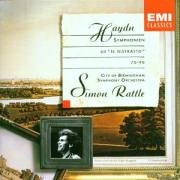| All Artists: Franz Joseph Haydn, Simon Rattle, City of Birmingham Symphony Orchestra Title: Haydn: Symphonies Nos. 60, 70 & 90 Members Wishing: 0 Total Copies: 0 Label: Angel Records Original Release Date: 1/1/1990 Re-Release Date: 4/3/2001 Genre: Classical Styles: Historical Periods, Classical (c.1770-1830), Symphonies Number of Discs: 1 SwapaCD Credits: 1 UPC: 077775429725 |
Search - Franz Joseph Haydn, Simon Rattle, City of Birmingham Symphony Orchestra :: Haydn: Symphonies Nos. 60, 70 & 90
 | Franz Joseph Haydn, Simon Rattle, City of Birmingham Symphony Orchestra Haydn: Symphonies Nos. 60, 70 & 90 Genre: Classical |
Larger Image |
CD Details |
CD ReviewsYouth Will Be Served: Bracing Performances of Haydn 05/06/2004 (5 out of 5 stars) "Like many listeners, I thought a number of Simon Rattle's EMI recordings with the CBSO showed a rare talent and one that would go far. The conductor's career seems not to be going so well in the bigger pond of Berlin, but still those early recordings of his are often treasurable. Among them, I include the current disc featuring three of Haydn's more festive symphonies. "Il Distratto," a work unlike just about every other 18th-century symphony (though some of Dittersdorf's program symphonies come close), is based on incidental music Haydn wrote for Jean-Francois Regnard's play "Le distrait." The "distracted" (or absent-minded) man of the title must be a pretty off-the-wall kind of guy because the symphony has some bizarre moments, the strangest being a moment in the prestissimo(!) finale when the orchestra comes to a crazily dissonant halt; next, the conductor taps the podium, followed by a retuning of the G string by all the string players. But there is also an elegant minuet surrounding a trio with some rather tipsy woodwind utterances. This is followed by a wild presto movement that starts in the minor key but ends with wild brass and timpani exclamations in major. This is in turn is succeeded by a tender adagio that trails off into an accelerando coda somewhat reminiscent of "All Around the Mulberry Bush!"The other two symphonies on the disc are far more conventional, though Symphony No. 70, with its heavy use of counterpoint and D-minor last movement that makes a hairpin turn to D major in the coda is at least uncommon. But so is No. 90, if only because this is one of Haydn's sunniest and most festive works, as well as one of his most forward-looking. With a finale that's longer than its first movement, the symphony confidently anticipates the great London Symphonies (especially Symphony No. 98) and early Beethoven.These works are the perfect assignment for the youthful Rattle and his orchestra, undoubtedly paired down for this recording. Rattle's balancing of his forces obviously takes its cue from the period-instrument movement because brass and winds are given their head here and are not overwhelmed by what is clearly a larger string body than you'd find in most period-instrument performances. The recording, made at the University of Warwick, helps also, being nicely reverberant but letting the detail come through beautifully. I would have liked a tad more presence from the horns but otherwise find the recording admirable. Given the vibrancy of the performances, the crackerjack playing of the orchestra, a fine recording, and the nice price, this is a very attractive way to acquire three bracing symphonies."
|
